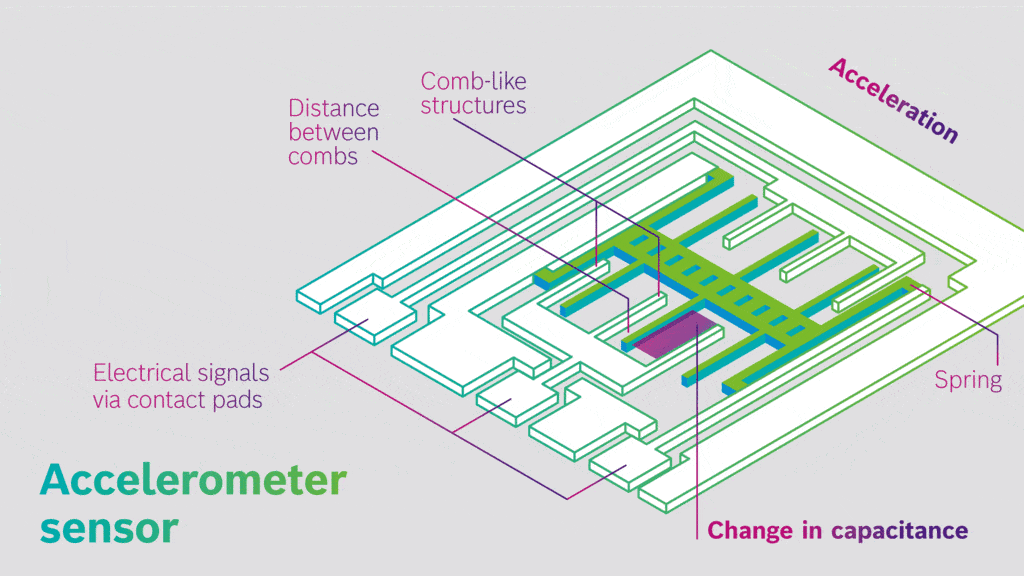Accelerometer: Detailed notes | Sensor & Industrial Instrumentation - Electronics and Communication Engineering (ECE) PDF Download
Accelerometer Sensor
The rate of change of velocity of the body with respect to time is called acceleration. According to relative theory, depending upon the relative object taken to measure acceleration, there are two types of acceleration. The proper acceleration, which is the physical acceleration of the body relative to inertia or the observer who is at rest relative to the object being measured. The coordinate acceleration depends upon the choice of coordinate system and choice of observers. This is not equal to proper acceleration. Accelerometer sensor is the electromechanical device used to measure the proper acceleration of the object.
The coordinate acceleration depends upon the choice of coordinate system and choice of observers. This is not equal to proper acceleration. Accelerometer sensor is the electromechanical device used to measure the proper acceleration of the object.
➢ Working Principle
The basic underlying working principle of an accelerometer is such as a dumped mass on a spring. When acceleration is experienced by this device, the mass gets displaced till the spring can easily move the mass, with the same rate equal to the acceleration it sensed. Then this displacement value is used to measure the give the acceleration.
Accelerometers are available as digital devices and analog devices. Accelerometers are designed using different methods. Piezoelectric, piezoresistive and capacitive components are generally used to convert the mechanical motion caused in accelerometer into an electrical signal.
Piezoelectric accelerometers are made up of single crystals. These use the piezoelectric effect to measure the acceleration. When applied to stress, these crystals generate a voltage which is interpreted to determine the velocity and orientation.
Capacitive accelerometers use a silicon micro-machined element. Here capacitance is generated when acceleration is sensed and this capacitance is translated into a voltage to measure the velocity values.
Modern accelerometers are the smallest MEMS, consisting of a cantilever beam with proof mass. Accelerometers are available as two-dimensional and three-dimensional forms to measure velocity along with orientation. When the upper-frequency range, high-temperature range, and low packaged weight are required, piezoelectric accelerometers are the best choice.
➢ Applications
The Applications of Accelerometer sensor are as follows:
- For inertial navigation systems, highly sensitive accelerometers are used.
- To detect and monitor vibrations in rotating machinery.
- To display images in an upright position on screens of digital cameras.
- For flight stabilization in drones.
- Accelerometers are used to sense orientation, coordinate acceleration, vibration, shock.
- Used to detect the position of the device in laptops and mobiles.
- High-frequency recording of biaxial and triaxial acceleration in biological applications for discrimination of behavioral patterns of animals.
- Machinery health monitoring.
- To detect faults in rotator machines.
- These are also used for building and structural monitoring to measure the motion and vibration of the structure when exposed to dynamic loads.
- To measure the depth of CPR chest compressions.
- Navigation systems make use of accelerometer sensors for knowing the direction.
- Remote sensing devices also use accelerometers to monitor active volcanoes.
➢ Uses/Examples
Some of the examples of the applications of accelerometer sensor are Aircrafts, missiles, Quake-catcher network for scientific research of earthquakes, pumps, fan, rollers, compressors, Zoll’s AED plus, footpods, Intelligent compaction rollers, airbag deployment system, electronic stability control system in automobiles, tilting trains, Gravimetry, camcorders, Glogger VS2, mobile phones etc…
|
22 videos|28 docs|29 tests
|
















